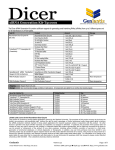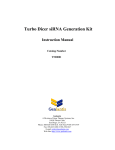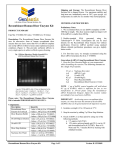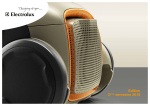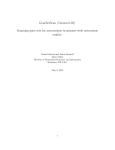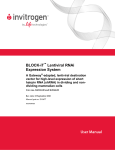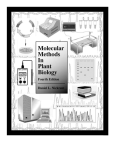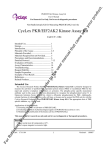Download siRNA Generation Kit
Transcript
siRNA Generation Kit-T520001 A division of Gene Therapy Systems, Inc. The Turbo Dicer siRNA Generation Kit contains sufficient reagents for generating small interfering RNAs (siRNAs) from up to 5 different genes and for 50 transfections in 24-well plates. Sub Kit Recombinant Turbo Dicer Enzyme Kit (50 units) TurboScript™ T7 Transcription Kit (5 reactions) GeneSilencer® siRNA Transfection Reagent Kit (50 transfections) RNA Purification Column 1 RNA Purification Column 2 Shipping Storage Content Recombinant Turbo Dicer Enzyme Turbo Dicer Reaction Buffer 50 mM MgCl2 Solution 10 mM ATP Turbo Dicer Stop Solution 5X BSA Nuclease-free Water T7 Enzyme Mix T7 Reaction Buffer NTP Mix DNase I 2X Gel Loading Buffer Nuclease-free Water LiCl Precipitation Solution GFP Control Plasmid 5’ Control Primer 3’ Control Primer GeneSilencer siRNA Transfection Reagent siRNA Diluent RNA Purification Column 1 Hydration Buffer RNA Purification Column 2 Amount 1 vial (100 µl @ 0.5 unit/µl) 1 vial (200 µl) 1 vial (25µl) 1 vial (50 µl) 1 vial (100 µl) 1 vial (50 µl) 1 vial (1 ml) 1 vial (10 µl) 1 vial (10 µl) 1 vial (40 µl) 1 vial (5 µl) 1 vial (175 µl) 1 vial (1 ml) 1 vial (175 µl) 1 vial (10 µl gWiz/GFP @ 1.0 µg/µl) 1 vial (10 µl @ 1.0 µg/µl) 1 vial (10 µl @ 1.0 µg/µl) 1 vial (180 µl) 1 vial (1.5 ml) 5 columns 1 bottle (4 ml) 5 columns Storage -20oC -20oC 4oC Room temperature Room temperature Shipped frozen (dry ice). See recommended storage conditions in table above. All components are stable for six months when stored properly. RELATED PRODUCTS Recombinant Human Dicer Enzyme Kit TurboScript™ T7 Transcription Kit RNA Purification Column 1 RNA Purification Column 2 Turbo Dicer siRNA Generation Kit Turbo Dicer Recombinant Enzyme Kit GeneSilencer® siRNA Transfection Reagent (0.75 ml) GeneSilencer® siRNA Transfection Reagent (5 x 0.75 ml) TurboCells® Chemically Competent E. coli TurboCells® F’ Chemically Competent E. coli Catalog Number T510002 T510003 T510004 T510005 T520001 T520002 T500750 T505750 C300020 C301020 Size 50 Units 20 Reactions 20 Columns 20 Columns ~50 Reactions 50 Units 200 Reactions 5 x 200 Reactions 20 x 50 µl single use tubes 20 x 50 µl single use tubes Limited Label License for the Recombinant Dicer Enzyme This product is covered by several patent applications owned by the Stanford University. The purchase of this product conveys to the buyer the limited, non-exclusive, non-transferable right (without the right to resell, repackage, or further sublicense) under these patent rights to perform the siRNA production methods claimed in those patent applications for research purposes solely in conjunction with this product. No other license is granted to the buyer whether expressly, by implication, by estoppel or otherwise. In particular, the purchase of this product does not include nor carry any right or license to use, develop, or otherwise exploit this product commercially, and no rights are conveyed to the buyer to use the product or components of the product for any other purposes, including without limitation, provision of services to a third party, generation of commercial databases, or clinical diagnostics or therapeutics. In addition, any user that purchases more than $5,000 in any calendar quarter may be outside the above research license and will contact Stanford University for a license. This product is sold pursuant to a license from Stanford University, and Stanford University reserves all other rights under these patent rights. For information on a license to the patent rights for uses other than in conjunction with this product or to use this product for purposes other than research, please contact Stanford Introduction to RNA Interference University at 650 723-0651. This is Stanford University reference S02-028. Genlantis 10190 Telesis Court. San Diego, CA 92121 VMV080922 Page 1 of 8 Toll Free: (888) 428-0558 « (858) 457-1919 « Web: http://www.genlantis.com Introduction to RNA Interference RNA interference (RNAi) has become an important tool for studying gene functions because it allows sequence specific gene suppression in a variety of organisms (e.g. plants, insects, and nematodes) and cultured mammalian cell lines. RNAi is characterized by targeted mRNA degradation after introduction of sequence-specific double stranded RNAs (dsRNAs) into cells (1,2,3). Several studies indicate that RNAi is an evolutionarily conserved defense mechanism directed against invading viral genomes or aberrant transcription products (4,5). In vitro studies using Drosophila lysates revealed that 21-25 nucleotide small interfering RNA duplexes (siRNAs) are the mediators of gene silencing. These siRNAs are derived from processing of the dsRNA by an RNase III-like enzyme (6,7,8). The mechanism involves the recruitment of siRNAs into a multi-protein complex known as RNA Induced Silencing Complex (RISC), which interacts with the target RNA to mediate cleavage in a catalytic fashion (6,9,10). Although cellular uptake of long trigger dsRNAs by organisms such as C. elegans and Drosophila has proven to be an effective method to induce RNAi, long dsRNAs tend to result in non-specific gene suppression in vertebrate cells due in part to Type I interferon response (11). Subsequent studies using synthetic siRNAs (less than 30 nucleotides) demonstrated that siRNAs can bypass the mammalian interferon response and cause effective genespecific silencing in mammalian cells (1,12). In addition, the gene silencing effect caused by siRNA can be detected even after many cell divisions. These properties make siRNA a useful tool for a broad range of research areas in mammalian cells. Figure 1. How Turbo Dicer siRNA Generation Kit Works How Turbo Dicer siRNA Generation Kit Works The Turbo Dicer siRNA Generation Kit mimics the natural RNA interference process by using recombinant human dicer enzyme, to cleave in vitro transcribed dsRNA into a pool of 22 bp siRNAs (Figure 1). The Turbo Dicer siRNA Generation Kit relies on two novel technologies for efficient siRNA production. First, the TurboScript™ T7 Transcription Kit utilizes a novel technology to allow rapid synthesis of 10 to 50 times the amount of RNA produced by conventional in vitro transcription reactions. The secret behind high yield is that each DNA template is copied hundreds of times. This ensures that you will have sufficient dsRNA after annealing the transcribed sense and antisense RNA strands. The second key technology is an enhanced form of the ultraactive human recombinant dicer enzyme, which cleaves >95% of dsRNA template into 22 bp siRNAs in 2 hours under optimized reaction conditions (Figure 2). With abundant supply of dsRNA templates and subsequent efficient dsRNA cleavage you are sure to have sufficient siRNAs in every single species to achieve gene silencing. Fig. 2. Efficient Digestion of Double-stranded RNA with Recombinant Human Turbo Dicer Enzyme 1 2 3 4 700 bp 22 bp Advantages of Turbo Dicer siRNA Generation Kit Compared to conventional siRNA construction methods such as chemical synthesis and hairpin siRNA expression vectors, the Turbo Dicer siRNA Generation Kit offers the following advantages: No guesswork – A mixture of siRNAs has a better chance of success than a single siRNA design. Fast and effective – effective digestion of dsRNA in two hours. Cost effective - No wasted time and money due to failed siRNAs. High efficiency-More regions of genes are screened for silencing. Ideal for use with GeneSilencer® siRNA Transfection Reagent. Genlantis 10190 Telesis Court. San Diego, CA 92121 VMV080922 Lane # 1 2 3 4 Sample 100 bp marker. 700 bp dsRNA, 1µg undigested. 700 bp dsRNA, 1 µg digested 15 hours with 1 unit Dicer Enzyme. 700 bp dsRNA, 1 g digested 2 hours with 1 unit of Turbo Dicer Enzyme Page 2 of 8 Toll Free: (888) 428-0558 « (858) 457-1919 « Web: http://www.genlantis.com MATERIALS AND METHODS 5’-GCG-TAATACGACTCACTATAGGGAGA--Target DNA--3’ 3’ --Target DNA--AGAGGGATATCACTCAGCATAAT-GCG-5’ 1. Generating Double-Stranded RNA (dsRNA) Template 1.1. Preparation of Template DNA for Transcription 1.1.1. Determining a target region The region selected for gene silencing does not seem to matter. You may follow a method suggested by Tuschl et al. (13) and pick a region of about 100150 nucleotides downstream from the start codon, which would prevent the dicedsiRNAs (dsiRNAs) from potentially competing with proteins involved in translation initiation. PCR 5’-GCGTAATACGACTCACTATAGGGAGA-Target-CTCCCTATAGTGAGTCGTATTACGC-3’ 3’-CGCATTATGCTGAGTGATATCCCTCT- DNA -AGAGGGATATCACTCAGCATAATGCG-5’ In vitro transcription sense 1.1.2. The size of the target template The Recombinant Turbo Dicer Enzyme performs best with double-stranded RNA (dsRNA) between 500-1000 bp in length. Dicer also works with longer dsRNAs, even full-length cDNAs. However, for silencing a single gene, using a 500 bp dsRNA is sufficient. We recommend that you use templates that are 500 – 1000 bp in length. dsRNA 1.1.3.2. PCR Protocol We recommend that you use the PCR Control Plasmid, which contains a 700 bp GFP gene as positive control template. Prepare a 100 µl reaction mix as follows: IMPORTANT 1) The yield of dsRNA might be low if the DNA template is smaller than 300 bp or the gene is GC rich and longer than 2 kb; 2) The Turbo Dicer Enzyme might not digest well if the dsRNA is smaller than 300 bp. 10 µl 1 µl 1 µl 1 µl 1 µl x µl 1.1.3. Adding T7 Promoters to the DNA template using PCR The DNA template must contain the T7 RNA polymerase promoter site at both ends so that it can be used as a template for in vitro transcription with the TurboScript™ T7 Transcription Kit. 86-x µl 94oC for 3 minutes 94oC for 30 seconds 58oC for 30 seconds 68oC for 1 minute/1kb NOTE The underlined sequence shown above is the minimum promoter sequence needed for efficient transcription. The + 1 base (in bold) is the first base incorporated into RNA during transcription. The 20-base T7 promoter region includes 2 bases which will form the first 2 bases of the transcribed RNA. Yields of transcription product are greatly reduced if the +1 or +2 G residues are changed. 1.1.4. Purification of PCR Product. It is important to use a clean PCR product to ensure high dsRNA yield. Purify PCR product as follows: 1.1.4.1. Add 1/10 volume of 3 M sodium acetate pH 5.3. 1.1.4.2. Add 2 volumes of ethanol. 1.1.4.3. Mix well and chill at –20°C for 30 min. 1.1.4.4. Pellet the DNA for 15-30 min in a microcentrifuge at top speed. 1.1.4.5. Remove the supernatant carefully. Resuspend the DNA pellet with 100 µl cold 70% ethanol. 1.1.4.6. Spin at top speed for 15 min. 1.1.4.7. Remove the supernatant carefully, and air-dry DNA pellet. 1.1.4.8. Resuspend the DNA in 20 µl of Nuclease-free Water and quantitate by spectrophotometry. Store at -20°C until later use. 5’-GCG-TAATACGACTCACTATAGGGAGA-NNNNNNNNNN-3’ Target DNA (~20 bases) 3’ Primer: 5’-GCG-TAATACGACTCACTATAGGGAGA-NNNNNNNNNN-3’ leader T7 promoter sequence Genlantis 10190 Telesis Court. San Diego, CA 92121 35 cycles 68oC for 5 minutes 4oC storage 1.1.3.1. Design gene-specific PCR primers by using the diagram below. We recommend using 20 bases that are gene specific in each primer. 5’ Primer: T7 promoter sequence 10 x PCR buffer 10 mM each dNTP DNA template (50 ng) 5’ primer (1µg/µl) 3’ primer (1µg/µl) DNA polymerase (Amount varies depending on the supplier) ddH2O PCR program: T7 promoter sequence: +1 TAATACGACTCACTATAGGGAGA leader antisense Target DNA (~20 bases) VMV080922 Page 3 of 8 Toll Free: (888) 428-0558 « (858) 457-1919 « Web: http://www.genlantis.com GenePORTER® Transfection Reagent Manual 1.2. Generation of dsRNA 1.2.1. Transcription Reaction Assembly 1.2.1.1. Thaw the frozen reagents. Place the T7 Enzyme Mix on ice; it is formulated in glycerol and does not freeze at –20°C. Vortex the T7 Reaction Buffer and the NTP Mix until they are completely in solution. Once thawed, store the NTP Mix on ice. Keep T7 Reaction Buffer at room temperature while assembling the reaction. IMPORTANT: All reagents should be microfuged briefly before opening to prevent loss and contamination of material that may be present around the rim of the tube. 1.2.1.2. Assemble the transcription reaction at room temperature. The following amounts are for a single 20 µl reaction. Reactions may be scaled up or down if desired. Add to 20 µl Nuclease-free Water 8 µl NTP mix 2 µl T7 Reaction Buffer 1 µg PCR template DNA (from step 1.1.4.8.) 2 µl T7 Enzyme Mix IMPORTANT: The spermidine in the T7 Reaction Buffer can co-precipitate the template DNA if the reaction is assembled on ice. Add the T7 Reaction Buffer after the water and the NTP Mix are already in the tube. 1.2.2. Gently flick the tube or pipette the mixture up and down gently, then microfuge the tube briefly so that the reaction mixture is at the bottom of the tube. 1.2.3. Incubate at 37°C for 2-4 hours. IMPORTANT: The first time a new template is transcribed, the recommended incubating 2–4 hours. To determine the optimum incubation time for maximum yield with a given template, a time-course experiment can be done. To do this, set up a TurboScript™ T7 Transcription reaction, and remove aliquots of the reaction at various intervals (for example after 1 hour, 2 hours, 4 hours, 6 hours, and overnight incubations). 1.2.4. To remove template DNA, add 1 µl DNase I to each 20 µl T7 Reaction. Mix well and incubate for 15 min at 37°C. 1.2.5. Check the dsRNA on a 1% agarose gel (TAE) by using the 2X Gel Loading Buffer. NOTE: dsRNA will migrate like DNA i.e. a 500 bp dsRNA will migrate at the same rate as a 500 bp band in a DNA ladder. ssRNA will migrate much faster than dsDNA of equivalent size. You may see faint slowermigrating bands above the full-length transcript on non-denaturing gels. These may be the result of secondary structures within the transcript and can be ignored. Genlantis 10190 Telesis Court. San Diego, CA 92121 VKM070426 1.3. Recovery of dsRNA dsRNA can be directly used with the Recombinant Turbo Dicer Enzyme Kit, but purified dsRNA, obtained from the following procedure, can give slightly better results: 1.3.1. Precipitate the RNA by adding 30 µl Nuclease-free Water and 30 µl LiCl Precipitation Solution to the mixture from Step 1.2.4. 1.3.2. Mix thoroughly. Chill for > 30 min at –20°C. 1.3.3. Centrifuge at 4°C for 15 minutes at maximum speed to pellet the RNA. 1.3.4. Carefully remove the supernatant. Wash the pellet once with ~1 ml 70% ethanol and centrifuge again to maximize removal of unincorporated nucleotides. 1.3.5. Carefully remove the 70% ethanol, and resuspend RNA in Nuclease-free Water or TE Buffer. Determine the RNA concentration and store at –20°C or –70°C. IMPORTANT: Lithium chloride precipitation may not efficiently precipitate RNAs smaller than 300 nucleotides, or if the concentration of RNA is lower than 0.1 µg/µl. To precipitate from TurboScript™ reactions that are thought to have low RNA yields, do not dilute the transcription reaction with water prior to adding the LiCl Precipitation Solution. 1.4. Quantitation of dsRNAs 1.4.1. Quantitation by UV light absorbance Reading the A260 of a diluted aliquot of the reaction is clearly the simplest way to determine yield, but any unincorporated nucleotides and/or template DNA in the mixture will contribute to the reading. Typically, a 1:500 dilution of an aliquot of a TurboScript™ reaction will give an absorbance reading in the linear range of a spectrophotometer. For RNA molecules, 1 A260 unit corresponds to 40 µg/ml, so the RNA yield can be calculated as follows: A260 x dilution factor x 40 = µg/ml RNA 1.4.2. Assessing dsRNA yield with RiboGreen® If you have a fluorometer, or a fluorescence microplate reader, Molecular Probes’ RiboGreen® fluorescence-based assay for RNA quantitation is a convenient and sensitive way to measure RNA concentration. Follow the manufacturer’s instructions for using RiboGreen®. 1.4.3. Quantitation by ethidium bromide fluorescence The intensity of ethidium bromide (EthBr) staining of dsRNA in an agarose gel can give a rough estimate of RNA yield. 1.4.3.1. Spot assay: If unincorporated nucleotides have been removed, an EthBr spot assay can be used to quantitate RNA concentration. Make a standard curve with several 2 fold dilutions of an RNA solution of known concentration. Start at about 80 ng/µl, and go down to about 1.25 ng/µl. Make a few dilutions of the unknown Page 4 of 8 Toll Free: (888) 428-0558 « (858) 457-1919 « Web: http://www.genlantis.com GenePORTER® Transfection Reagent Manual RNA, and add EthBr to 1 ng/µl to each dilution of both RNAs. Spot 2 µl of the control RNA samples and the unknown RNA dilutions onto plastic wrap placed on a UV transilluminator. Compare the fluorescence of the RNAs to estimate the concentration of the sample RNA. Make sure that the sample dilutions are in the linear range of EthBr fluorescence. This assay will detect as little as 5 ng of RNA with an error of about 2 fold. 1.4.3.2. Denaturing gel electrophoresis: If unincorporated nucleotides have not been removed from the reaction, an aliquot of the TurboScript™ reaction should be run on a denaturing agarose or acrylamide gel alongside an aliquot of RNA of known concentration. Stain the samples with EthBr, and simply compare the intensity of the unknown sample to that of the known RNA sample to estimate its concentration. 2. Generating siRNAs Using Turbo Dicer Enzyme 2.1. Turbo Dicer Reaction 2.1.1. Keep the Turbo Dicer Reaction Buffer at room temperature while assembling the reaction. The following amounts are for a single 10 µl reaction: 3.0 µl -x Nuclease-free water x µl dsRNA (1 µg) 1.0 µl 10 mM ATP 1.0 µl 5X BSA 2.0 µl 50 mM MgCl2 1.0 µl Turbo Dicer Reaction Buffer 2.0 µl Turbo Dicer Enzyme (0.5 Units/µl) IMPORTANT: Avoid using excess Turbo Dicer Enzyme; it may decrease the amount of diced siRNA (dsiRNA) generated from the reaction. 1 µg of dsRNA control template will yield ~0.5 µg of dsiRNA, which is sufficient for one or two transfections in 24-well plates using the GeneSilencer siRNA Transfection Reagent. Adjust the reaction volume accordingly if you need more dsiRNAs. 2.1.2. Incubate for two hours at 37°C. Avoid overdigesting dsRNA for longer than 2 hours. 2.1.3. Add 2 µl Turbo Dicer Stop Solution to stop the reaction. 2.1.4. Check dsiRNA (~22 base pairs) by using one of the following methods: a. 3 % agarose Gel (TAE). b. 15% native polyacrylamide gel (29:1, cast in 1X and electrophoresed in 0.5X TBE). Run at 10 Watts, 4°C. Visualize RNA by EthBr staining. 2.2. Purification of siRNAs 2.2.1. Removing salts and unincorporated nucleotides with RNA Purification Column 1. IMPORTANT: This step requires a fixed-angle-rotor microcentrifuge. On a variable speed microcentrifuge, DO NOT use the pulse button, which overrides the speed setting and takes the rotor to maximum g-force Genlantis 10190 Telesis Court. San Diego, CA 92121 VKM070426 2.2.1.1. Tap the RNA Purification Column 1 to settle the dry gel in the bottom of the spin column. 2.2.1.2. Hydrate the column with 650 µl of Hydration Buffer. Cap, vortex, tap out air bubbles, and hydrate at room temperature 5–15 min. 2.2.1.3. (Optional) Once hydrated, these columns can be stored in the refrigerator up to 3 days. 2.2.1.4. Spin the column at 750 x g for 4 min to remove excess interstitial fluid, keeping track of the orientation of the column in the rotor by marking the column. 2.2.1.5. Discard the wash tube and immediately apply the sample (20–100 µl) DIRECTLY TO THE CENTER OF THE GEL BED at the top of the column without disturbing the gel surface or contacting the sides of the column with the pipette tip or reaction mixture. 2.2.1.6. Place the column in the sample collection tube and place in the rotor, maintaining the same orientation as in Step 2.2.1.4. 2.2.1.7. Spin the column in the tube at 750 x g for 3 min. Your sample will be in the collection tube. 2.2.2. Removing undigested dsRNA with RNA Purification Column 2. 2.2.2.1. Insert the sample reservoir into one of the vials provided. 2.2.2.2. Add 10 µl of nuclease free water into the sample reservoir without touching the membrane with the pipette tip. Seal the attached cap. 2.2.2.3. Place the assembly in a microcentrifuge and counterbalance with a similar device. Spin at 500 x g for 2 minutes. Empty any nuclease free water in the collection tube. 2.2.2.4. Add the samples from step 2.2.1.7 into the sample reservoir without touching the membrane with the pipette tip. Seal with the attached cap. 2.2.2.5. Place assembly in a microcentrifuge and counterbalance with a similar device. Spin at 500 x g for 15 minutes (do not centrifuge more than 15 minutes). 2.2.2.6. Remove assembly from centrifuge. Separate collection vial from sample reservoir. Purified dsiRNA is in the collection vial, undigested large dsRNAs remain in the sample reservoir. 2.2.2.7. Store the dsiRNA at –20°C. 2.2.3. Qualification of Purification Products For RNA molecules, 1 A260 unit corresponds to 40 µg/ml; siRNA yield can be calculated as follows: A260 X dilution factor X 40 = µg/ml RNA NOTE: Typically, each microgram of dsRNA yields about 0.5 µg of dsiRNA Page 5 of 8 Toll Free: (888) 428-0558 « (858) 457-1919 « Web: http://www.genlantis.com GenePORTER® Transfection Reagent Manual 3. Transfecting dsiRNA with the GeneSilencer® siRNA Transfection Reagent 3.1. Transfection Optimization Guidelines 3.1.1. Adherent cells: Although GeneSilencer® consistently delivers high transfection efficiencies in a wide range of cell types, to obtain maximum efficiency in particular cell lines some optimization may be needed. The two critical variables are 1) GeneSilencer/siRNA ratio and 2) siRNA quantity. To optimize these two variables: a). Determine the best GeneSilencer®/siRNA ratio by using 0.5 - 7 µl of reagent for each 100 ng of siRNA. Use a low siRNA quantity to optimize this parameter. b). Once the optimal ratio has been established, vary the siRNA quantity over the suggested range. At this point, cell number can also be optimized. 3.1.2. Suspension cells: For suspension cells the optimization procedure is the same as for adherent cells except that the GeneSilencer®/siRNA ratio is higher IMPORTANT: Gene suppression was observed with GFP dsiRNA generated from the GFP Control Plasmid. Co-transfection of 1 µg of GFP Control Plasmid and 500 ng of dsiRNA resulted in 60% suppression of GFP expression in transiently transfected NIH 3T3 cells. 3.2. Transfection of Adherent Cells 3.2.1. The day before transfection, plate cells so that they will be 50-70% confluent on the day of transfection. 3.2.2. Prepare the GeneSilencer® Reagent by diluting in serum free medium according to the recommended amount in Table 1 below: Table 1: GeneSilencer® Dilutions For Adherent Cells Tissue culture plate or dish type GeneSilencer® Reagent (µl) + serum ree medium (µl) per well 96 wells 48 wells 24 wells 1.0 + 25 1.75 + 25 3.5 + 25 3.2.3. Prepare the siRNA solution by first mixing the siRNA Diluent and serum free medium (SFM) according to Table 2 below. Use the Diluent/SFM mix to dilute the recommended amount of dsiRNA in Table 2. Mix well by pipetting up and down several times. Incubate at room temperature for 5 minutes. IMPORTANT: Avoid vortexing the siRNA/Diluent mix. Table 2: siRNA Dilutions For Adherent Cells Tissue culture plate type 96 wells 48 wells 24 wells Recommended amount of dsiRNA (ng/well) 125 250 500 siRNA Diluent (µl)+ serum free medium (µl/well) Final transfection volume (µl) 2.5 + 15 5.0 + 15 10.0 + 15 100 200 500 temperature for 5 minutes to allow the siRNA/lipid complexes to form. IMPORTANT: You can incubate the siRNA/GeneSilencer® mix for longer than 5 minutes, but make sure not to exceed 30 minutes in order to maintain maximum siRNA transfection efficiency. 3.2.5. Add the siRNA/GeneSilencer® mix to cells growing in serum-containing medium. Incubate at 37°C for 24 hours. See Table 2 for final transfection volume. NOTE: For some cell lines like HeLa, MDCK, and CHOK1, transfection efficiencies may be higher if serum is omitted from the medium during the first 4 hours of transfection. After this step, add one volume of medium containing 20% serum, then proceed to step 3.2.6. 3.2.6. Add fresh tissue culture medium to growing cells as needed. Most RNA interference can be detected within 48 hours post transfection. 3.3. Transfection of Suspension Cells 3.3.1. The day before transfection, split the cells as necessary to optimize their health and achieve log-growth by transfection time. 3.3.2. Prepare the GeneSilencer® Reagent by diluting in serum free medium according to the recommended amount in Table 1 above. 3.3.3. Prepare the dsiRNA solution by first mixing the siRNA Diluent and serum free medium (SFM) according to Table 4 below. Use the Diluent/SFM mix to dilute the recommended amount of dsiRNA in Table 4. Mix well by pipetting up and down several times. Incubate at room temperature for 5 minutes. IMPORTANT: Avoid vortexing the siRNA/Diluent mix. Table 4: siRNA Dilutions For Suspension Cells Tissue culture plate type 96 wells 48 wells 24 wells Recommended amount siRNA Diluent (µl)+serum of dsiRNA (ng/well) free medium (µl/well) 125 2.5 + 15 250 5.0 + 15 500 10.0 + 15 3.3.4. Add the dsiRNA solution from Step 3.3.3 to the diluted GeneSilencer® solution from Step 3.3.2. Incubate at room temp. for 5 minutes to form the siRNA/lipid complexes. IMPORTANT: See IMPORTANT note in 3.2.4. 3.3.5. While the siRNA/GeneSilencer mix is incubating, spin down the cells from Step 3.3.1, remove the growth medium and re-suspend the cells in the appropriate growth medium (serum-free or serum-containing) to achieve a final cell density listed in Table 5. 3.3.6. Transfer resuspended cells to culture plates according to Table 5 below: 3.2.4. Add the RNA solution from Step 3.2.3 to the diluted GeneSilencer solution from Step 3.2.2. Incubate at room Genlantis 10190 Telesis Court. San Diego, CA 92121 VKM070426 Page 6 of 8 Toll Free: (888) 428-0558 « (858) 457-1919 « Web: http://www.genlantis.com GenePORTER® Transfection Reagent Manual Table 5: Volume and Cell Number to Transfer Into Culture Dishes. Tissue culture Resuspended cells Number of cells plate or dish volume to transfer to each transferred to each type well (ml) well (approx.) 96 wells 48 wells 24 wells 0.1 0.2 0.5 1 x 105 2 x 105 5 x 105 3.3.7. Add the siRNA/GeneSilencer® mix to resuspended cells in Table 5 above. Gently mix the cells by pipetting up and down several times to avoid cell clumping. Incubate at 37°C for 24 hours. 3.3.8. Add fresh tissue culture medium to growing cells as needed. Most RNA interference can be detected within 48 hours post transfection. References 1. 2. 3. 4. 5. 6. 7. 8. 9. 10. 11. 12. 13. Caplen, N.J., S. Parrish, F. Imani, A. Fire and R.A. Morgan. 2001. Specific inhibition of gene expression by small double-stranded RNAs in invertebrate and vertebrate systems. Proc Natl Acad Sci U S A 98:9742-9747 Grishok, A., A.E. Pasquinelli, D. Conte, N. Li, S. Parrish, I. Ha, D.L. Baillie, A. Fire, G. Ruvkun and C.C. Mello. 2001. Genes and mechanisms related to RNA interference regulate expression of the small temporal RNAs that control C. elegans developmental timing. Cell 106:23-34 Parrish, S., J. Fleenor, S. Xu, C. Mello and A. Fire. 2000. Functional anatomy of a dsRNA trigger: differential requirement for the two trigger strands in RNA interference. Mol Cell 6:1077-1087. Hamilton, A.J. and D.C. Baulcombe. 1999. A species of small antisense RNA in posttranscriptional gene silencing in plants. Science 286:950-952. Sijen, T., J. Fleenor, F. Simmer, K.L. Thijssen, S. Parrish, L. Timmons, R.H. Plasterk and A. Fire. 2001. On the role of RNA amplification in dsRNA-triggered gene silencing. Cell 107:465-476. Bernstein, E., A.A. Caudy, S.M. Hammond and G.J. Hannon. 2001. Role for a bidentate ribonuclease in the initiation step of RNA interference. Nature 409:363-366. Hutvagner, G., J. McLachlan, A.E. Pasquinelli, E. Balint, T. Tuschl and P.D. Zamore. 2001. A cellular function for the RNA-interference enzyme Dicer in the maturation of the let-7 small temporal RNA. Science 293:834-838. Knight, S.W. and B.L. Bass. 2001. A role for the RNase III enzyme DCR-1 in RNA interference and germ line development in Caenorhabditis elegans. Science 293:2269-2271. Boutla, A., C. Delidakis, I. Livadaras, M. Tsagris and M. Tabler. 2001. Short 5'-phosphorylated double-stranded RNAs induce RNA interference in Drosophila. Curr Biol 11:1776-1780. Hammond, S.M., E. Bernstein, D. Beach and G.J. Hannon. 2000. An RNA-directed nuclease mediates post-transcriptional gene silencing in Drosophila cells. Nature 404:293296. Ui-Tei, K., S. Zenno, Y. Miyata and K. Saigo. 2000. Sensitive assay of RNA interference in Drosophila and Chinese hamster cultured cells using firefly luciferase gene as target. FEBS Lett 479:79-82. Elbashir, S.M., J. Harborth, W. Lendeckel, A. Yalcin, K. Weber and T. Tuschl. 2001. Duplexes of 21-nucleotide RNAs mediate RNA interference in cultured mammalian cells. Nature 411:494-498. Elbashir SM, Harborth J, Weber K, Tuschl T. 2002. Analysis of gene function in somatic mammalian cells using small interfering RNAs. Methods. 26(2):199-213. Genlantis 10190 Telesis Court. San Diego, CA 92121 VKM070426 Page 7 of 8 Toll Free: (888) 428-0558 « (858) 457-1919 « Web: http://www.genlantis.com GenePORTER® Transfection Reagent Manual APPENDIX Quality Control All components in the TurboScript™ T7 Transcription Kit are functionally tested by PCR amplification of the GFP Control Plasmid. Each 20 µl reaction yields at least 50–80 µg of dsRNA after a 4 hour incubation. Recombinant Turbo Dicer Enzyme Kit components are tested using 1 µg of dsRNA (from the GFP Control Plasmid). At least 0.5 µg of dsiRNA must be produced after 12-18 hours of incubation. The GeneSilencer® siRNA Transfection Kit is functionally qualified by transfecting labeled siRNA in cultured cells. Troubleshooting Guide Problem Difficulty obtaining PCR products for the full-length gene of interest Possible Causes Recommended Solutions Sub-optimal primer design. Re-design primers by changing the gene-specific portions of the primers and optimize the PCR conditions. Amplify portions of the gene in 500 to 700 bp fragments and proceed to transcribe dsRNAs from these fragments. Double check you have followed the procedure accurately; consider trying the control reaction a second time. If the control still fails, this indicates that a kit component may have expired. Call Genlantis for troubleshooting and support. Check the amount and quality of template. Also, check an aliquot of the template DNA on an agarose gel to make sure it is intact and that it is the expected size. Use a different DNA polymerase if possible and/or extend reaction time. Optimize transcription reaction condition by doubling the amount of GTP and CTP, performing the reaction at 15°C, and adding 0.5-1% DMSO. Check the amount of dsRNA added. Make sure that the correct fractions from the RNA Purification Columns are used or purify dsRNA before dicer reaction. Use 1 unit of the Turbo Dicer Enzyme for every microgram of dsRNA. The gene is too long. Neither template nor control reaction work in generating dsRNA. The control reaction works with the TurboScript™ T7 Transcription Kit, but template gives low dsRNA yield. dsiRNA yield is low. Low Transfection Efficiency Expired or defective kit component. Wrong amount of DNA template or poor DNA quality. PCR products of poor quality. DNA template has high G/C content. No dsRNA or poor dsRNA quality. Too much Turbo Dicer Enzyme added. 10 mM ATP is old. Sub-optimal GeneSilencer /siRNA ratio or Suboptimal siRNA concentration. Denatured siRNA Over-digestion of dsRNA Cells have been in continuous passage for > 2 months Sub-optimal cell density. Improper storage. Wrong medium. Cell line is difficult to transfect. Cytotoxicity GeneSilencer/ siRNA complexes not freshly prepared. Sub-optimal GeneSilencer /siRNA ratio used. Unhealthy cells. Aggregation GeneSilencer concentration Excess GeneSilencer used. Genlantis 10190 Telesis Court. San Diego, CA 92121 Use fresh ATP solution. Optimize the GeneSilencer/siRNA ratio by using 0.5-7 µl of GeneSilencer for each 100 ng of siRNA. Use a low siRNA quantity to optimize this parameter. After establishing the optimal GeneSilencer /siRNA ratio, vary the siRNA quantity over the ranges suggested in the Methods and Procedures section. Use recommended buffer (100 mM NaCl, 50 mM Tris, pH 7.5 in RNase-free water) to dilute siRNA. Do not use water as it can denature the siRNA. Make sure you do NOT digest the dsRNA for longer than 2 hours with the Turbo Dicer Enzyme. Thaw out a fresh aliquot of cells and passage once (or more) before transfecting. Avoid using cells that have been in culture or passaged for an excessive time. Use cells that are 50-70% confluent on the day of transfection. Optimal cell density may vary depending on cell type. GeneSilencer reagent is very stable but long exposure to elevated temperatures and/or excessive freeze/thaw cycles may cause degradation; store at 4°C. Use ONLY serum-free medium when forming GeneSilencer/siRNA complex. Optimize GeneSilencer/siRNA ratio and siRNA amount as indicated on page 6 (Section 3.1). GeneSilencer/siRNA complexes should be freshly prepared. If complexes have been prepared and stored for longer than 45 minutes, aggregation may occur. Too much GeneSilencer or too much siRNA could cause aggregation; Adjust the ratio as outlined above. - Check cells for contamination. - Thaw a new batch of cells. - Cells are too confluent or cell density too low. - Check culture medium (pH, kind used, last time changed). - Check equipment for proper function (culture plates, incubators, etc.). Reduce GeneSilencer concentration in 20-30% increments to avoid toxicity. Decrease the amount of GeneSilencer reagent. VKM070426 Page 8 of 8 Toll Free: (888) 428-0558 « (858) 457-1919 « Web: http://www.genlantis.com








